Oman Arab Bank: Leadership, Structure, and Sector Analysis Report
VerifiedAdded on 2022/01/05
|20
|6724
|22
Report
AI Summary
This report provides an analysis of the leadership and organizational structure of the Oman Arab Bank, focusing on its strategies and sector dynamics within the banking industry. It begins by defining leadership and its various styles, then explores how these styles are applied in different cultural contexts, including the UK, the US, and the GCC countries. The report examines different leadership styles, such as autocratic, democratic, and laissez-faire, and their impact on employee performance. It also discusses the importance of leadership capabilities like motivation, accountability, and time management. The report then delves into the specific structures and systems of Oman Arab Bank, including its transformation strategy, functional organizational structure, and participative leadership style. It compares Oman Arab Bank's structure and leadership to those of the Bank of Muscat and HSBC, highlighting the differences and their implications. Finally, the report assesses the growth of the banking sector in Oman, its resilience to global economic fluctuations, and the factors contributing to its success, such as professionalism and strong corporate governance. This report is a valuable resource for students studying leadership and management in the banking sector.
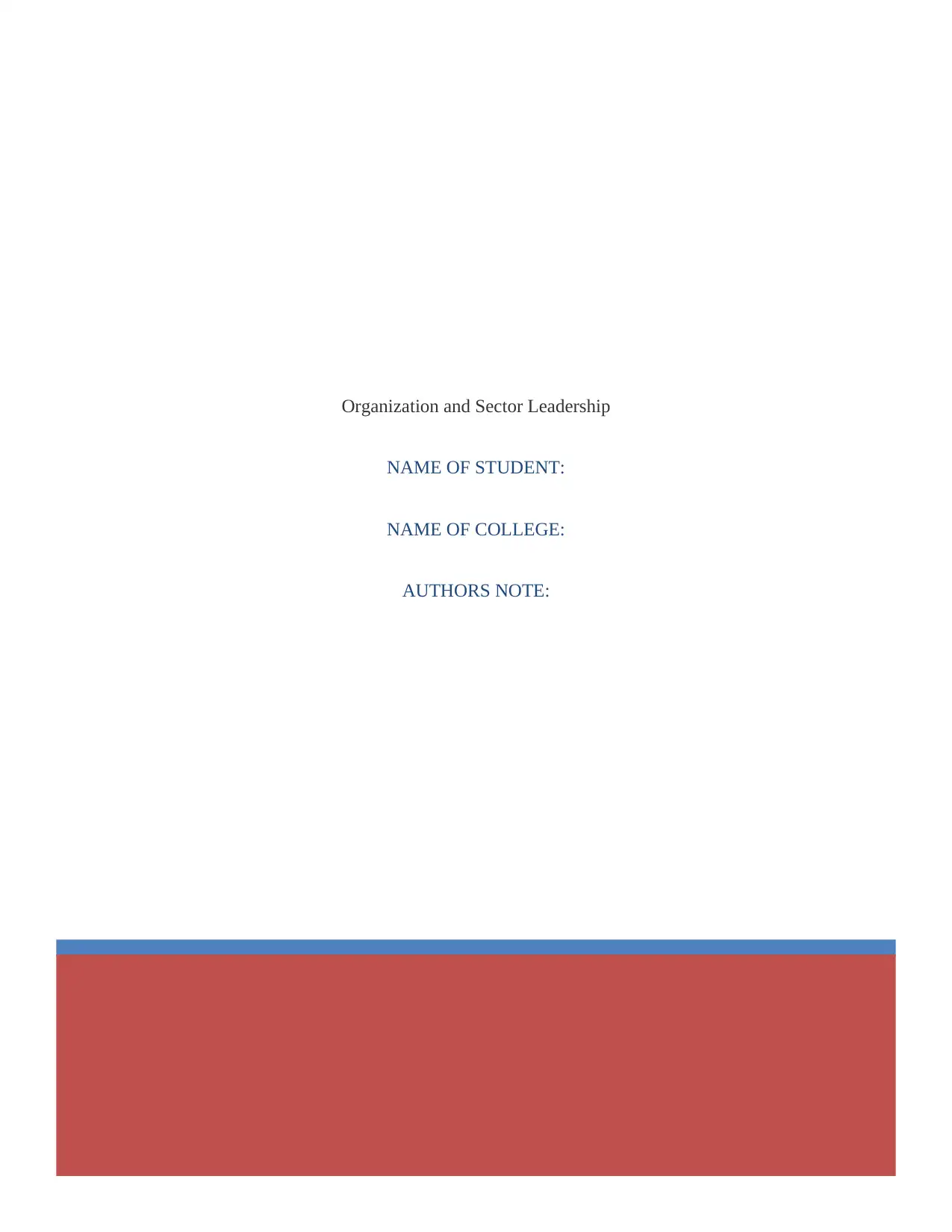
Organization and Sector Leadership
NAME OF STUDENT:
NAME OF COLLEGE:
AUTHORS NOTE:
NAME OF STUDENT:
NAME OF COLLEGE:
AUTHORS NOTE:
Paraphrase This Document
Need a fresh take? Get an instant paraphrase of this document with our AI Paraphraser
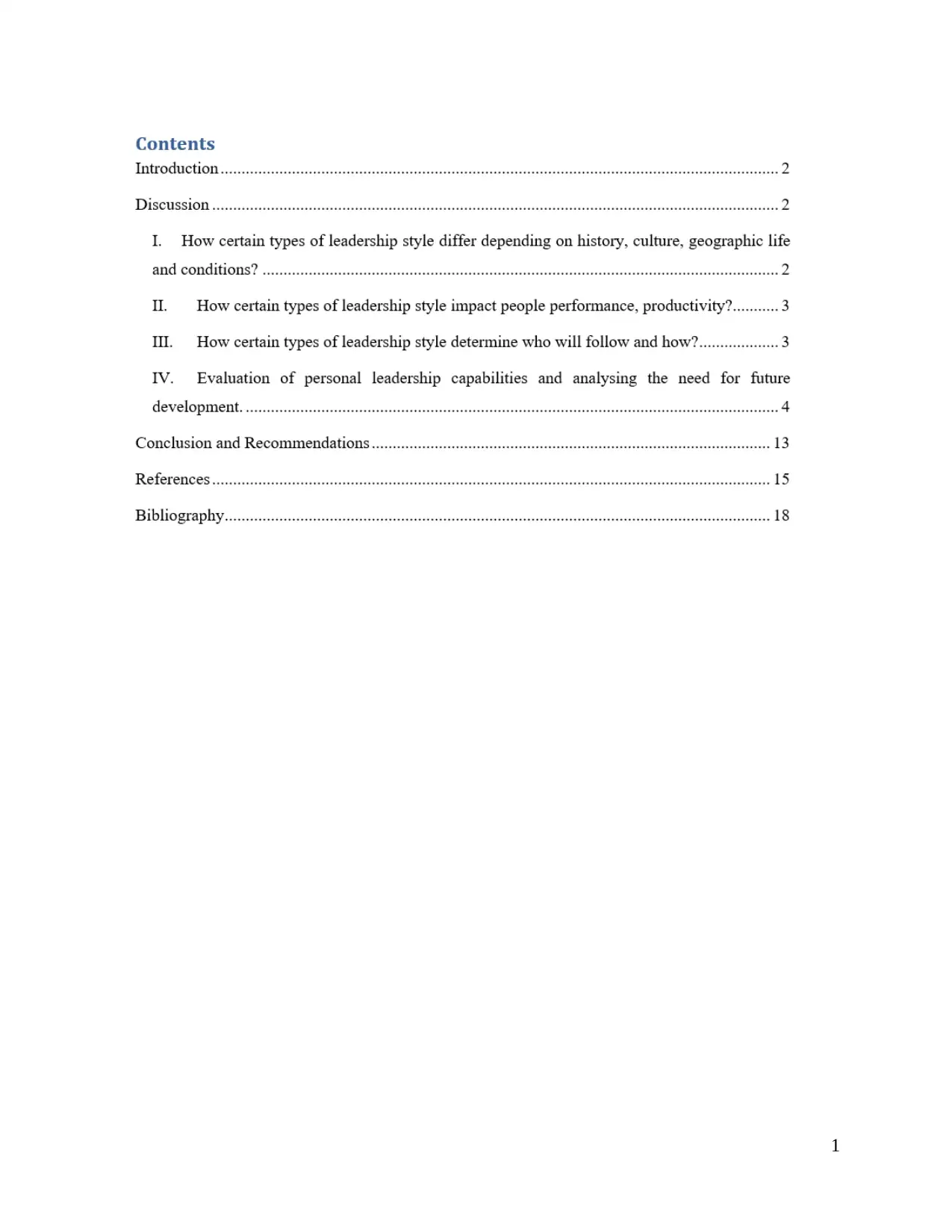
1
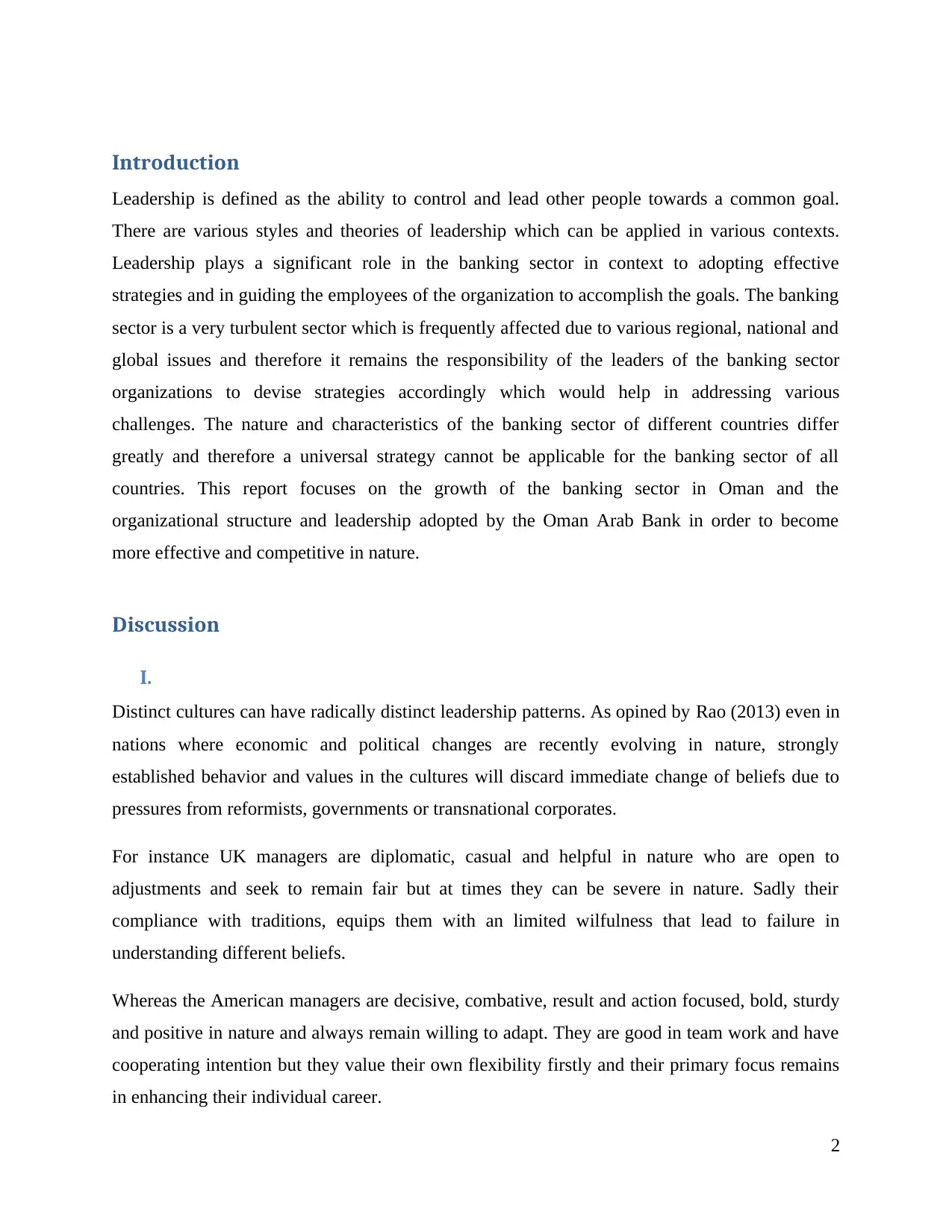
Introduction
Leadership is defined as the ability to control and lead other people towards a common goal.
There are various styles and theories of leadership which can be applied in various contexts.
Leadership plays a significant role in the banking sector in context to adopting effective
strategies and in guiding the employees of the organization to accomplish the goals. The banking
sector is a very turbulent sector which is frequently affected due to various regional, national and
global issues and therefore it remains the responsibility of the leaders of the banking sector
organizations to devise strategies accordingly which would help in addressing various
challenges. The nature and characteristics of the banking sector of different countries differ
greatly and therefore a universal strategy cannot be applicable for the banking sector of all
countries. This report focuses on the growth of the banking sector in Oman and the
organizational structure and leadership adopted by the Oman Arab Bank in order to become
more effective and competitive in nature.
Discussion
I.
Distinct cultures can have radically distinct leadership patterns. As opined by Rao (2013) even in
nations where economic and political changes are recently evolving in nature, strongly
established behavior and values in the cultures will discard immediate change of beliefs due to
pressures from reformists, governments or transnational corporates.
For instance UK managers are diplomatic, casual and helpful in nature who are open to
adjustments and seek to remain fair but at times they can be severe in nature. Sadly their
compliance with traditions, equips them with an limited wilfulness that lead to failure in
understanding different beliefs.
Whereas the American managers are decisive, combative, result and action focused, bold, sturdy
and positive in nature and always remain willing to adapt. They are good in team work and have
cooperating intention but they value their own flexibility firstly and their primary focus remains
in enhancing their individual career.
2
Leadership is defined as the ability to control and lead other people towards a common goal.
There are various styles and theories of leadership which can be applied in various contexts.
Leadership plays a significant role in the banking sector in context to adopting effective
strategies and in guiding the employees of the organization to accomplish the goals. The banking
sector is a very turbulent sector which is frequently affected due to various regional, national and
global issues and therefore it remains the responsibility of the leaders of the banking sector
organizations to devise strategies accordingly which would help in addressing various
challenges. The nature and characteristics of the banking sector of different countries differ
greatly and therefore a universal strategy cannot be applicable for the banking sector of all
countries. This report focuses on the growth of the banking sector in Oman and the
organizational structure and leadership adopted by the Oman Arab Bank in order to become
more effective and competitive in nature.
Discussion
I.
Distinct cultures can have radically distinct leadership patterns. As opined by Rao (2013) even in
nations where economic and political changes are recently evolving in nature, strongly
established behavior and values in the cultures will discard immediate change of beliefs due to
pressures from reformists, governments or transnational corporates.
For instance UK managers are diplomatic, casual and helpful in nature who are open to
adjustments and seek to remain fair but at times they can be severe in nature. Sadly their
compliance with traditions, equips them with an limited wilfulness that lead to failure in
understanding different beliefs.
Whereas the American managers are decisive, combative, result and action focused, bold, sturdy
and positive in nature and always remain willing to adapt. They are good in team work and have
cooperating intention but they value their own flexibility firstly and their primary focus remains
in enhancing their individual career.
2
⊘ This is a preview!⊘
Do you want full access?
Subscribe today to unlock all pages.

Trusted by 1+ million students worldwide
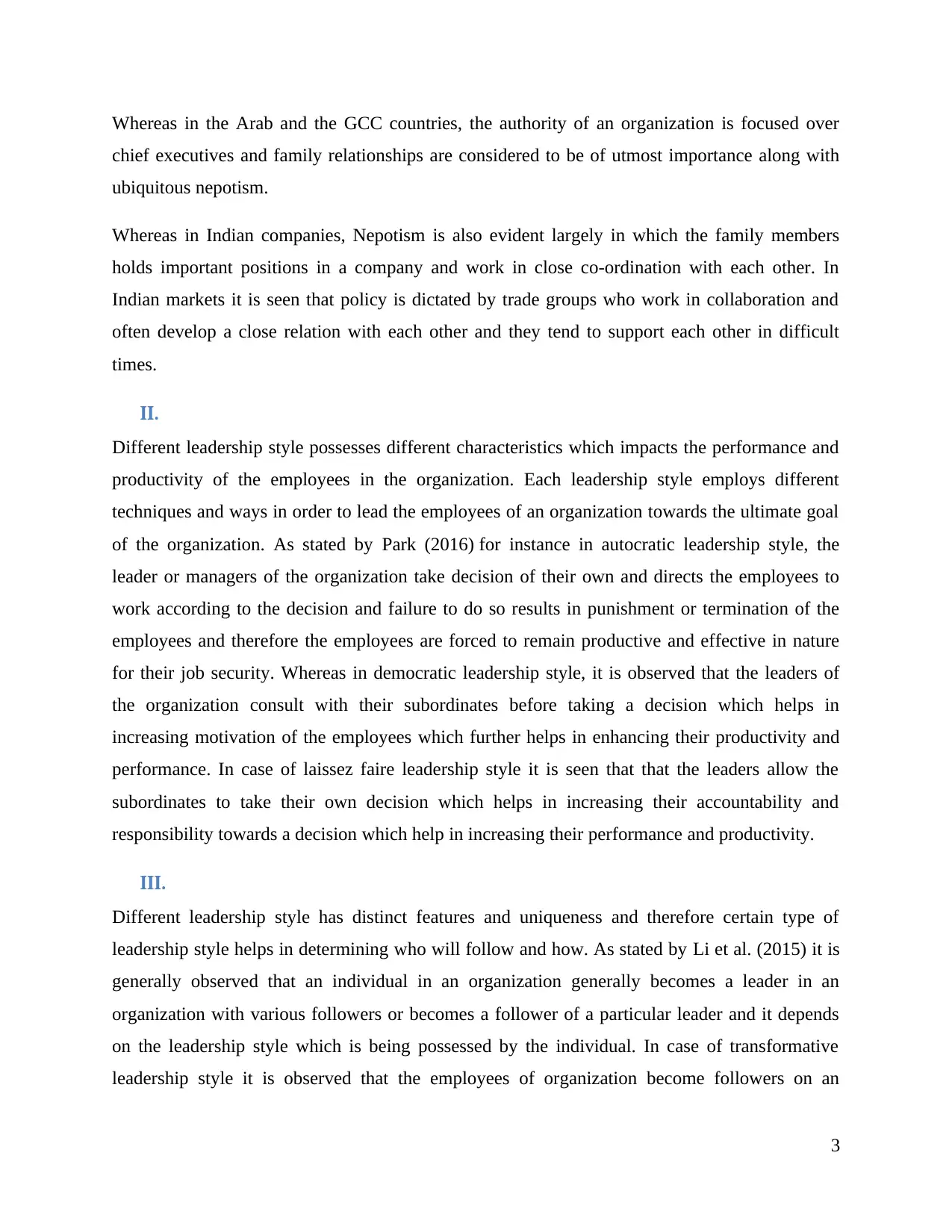
Whereas in the Arab and the GCC countries, the authority of an organization is focused over
chief executives and family relationships are considered to be of utmost importance along with
ubiquitous nepotism.
Whereas in Indian companies, Nepotism is also evident largely in which the family members
holds important positions in a company and work in close co-ordination with each other. In
Indian markets it is seen that policy is dictated by trade groups who work in collaboration and
often develop a close relation with each other and they tend to support each other in difficult
times.
II.
Different leadership style possesses different characteristics which impacts the performance and
productivity of the employees in the organization. Each leadership style employs different
techniques and ways in order to lead the employees of an organization towards the ultimate goal
of the organization. As stated by Park (2016) for instance in autocratic leadership style, the
leader or managers of the organization take decision of their own and directs the employees to
work according to the decision and failure to do so results in punishment or termination of the
employees and therefore the employees are forced to remain productive and effective in nature
for their job security. Whereas in democratic leadership style, it is observed that the leaders of
the organization consult with their subordinates before taking a decision which helps in
increasing motivation of the employees which further helps in enhancing their productivity and
performance. In case of laissez faire leadership style it is seen that that the leaders allow the
subordinates to take their own decision which helps in increasing their accountability and
responsibility towards a decision which help in increasing their performance and productivity.
III.
Different leadership style has distinct features and uniqueness and therefore certain type of
leadership style helps in determining who will follow and how. As stated by Li et al. (2015) it is
generally observed that an individual in an organization generally becomes a leader in an
organization with various followers or becomes a follower of a particular leader and it depends
on the leadership style which is being possessed by the individual. In case of transformative
leadership style it is observed that the employees of organization become followers on an
3
chief executives and family relationships are considered to be of utmost importance along with
ubiquitous nepotism.
Whereas in Indian companies, Nepotism is also evident largely in which the family members
holds important positions in a company and work in close co-ordination with each other. In
Indian markets it is seen that policy is dictated by trade groups who work in collaboration and
often develop a close relation with each other and they tend to support each other in difficult
times.
II.
Different leadership style possesses different characteristics which impacts the performance and
productivity of the employees in the organization. Each leadership style employs different
techniques and ways in order to lead the employees of an organization towards the ultimate goal
of the organization. As stated by Park (2016) for instance in autocratic leadership style, the
leader or managers of the organization take decision of their own and directs the employees to
work according to the decision and failure to do so results in punishment or termination of the
employees and therefore the employees are forced to remain productive and effective in nature
for their job security. Whereas in democratic leadership style, it is observed that the leaders of
the organization consult with their subordinates before taking a decision which helps in
increasing motivation of the employees which further helps in enhancing their productivity and
performance. In case of laissez faire leadership style it is seen that that the leaders allow the
subordinates to take their own decision which helps in increasing their accountability and
responsibility towards a decision which help in increasing their performance and productivity.
III.
Different leadership style has distinct features and uniqueness and therefore certain type of
leadership style helps in determining who will follow and how. As stated by Li et al. (2015) it is
generally observed that an individual in an organization generally becomes a leader in an
organization with various followers or becomes a follower of a particular leader and it depends
on the leadership style which is being possessed by the individual. In case of transformative
leadership style it is observed that the employees of organization become followers on an
3
Paraphrase This Document
Need a fresh take? Get an instant paraphrase of this document with our AI Paraphraser
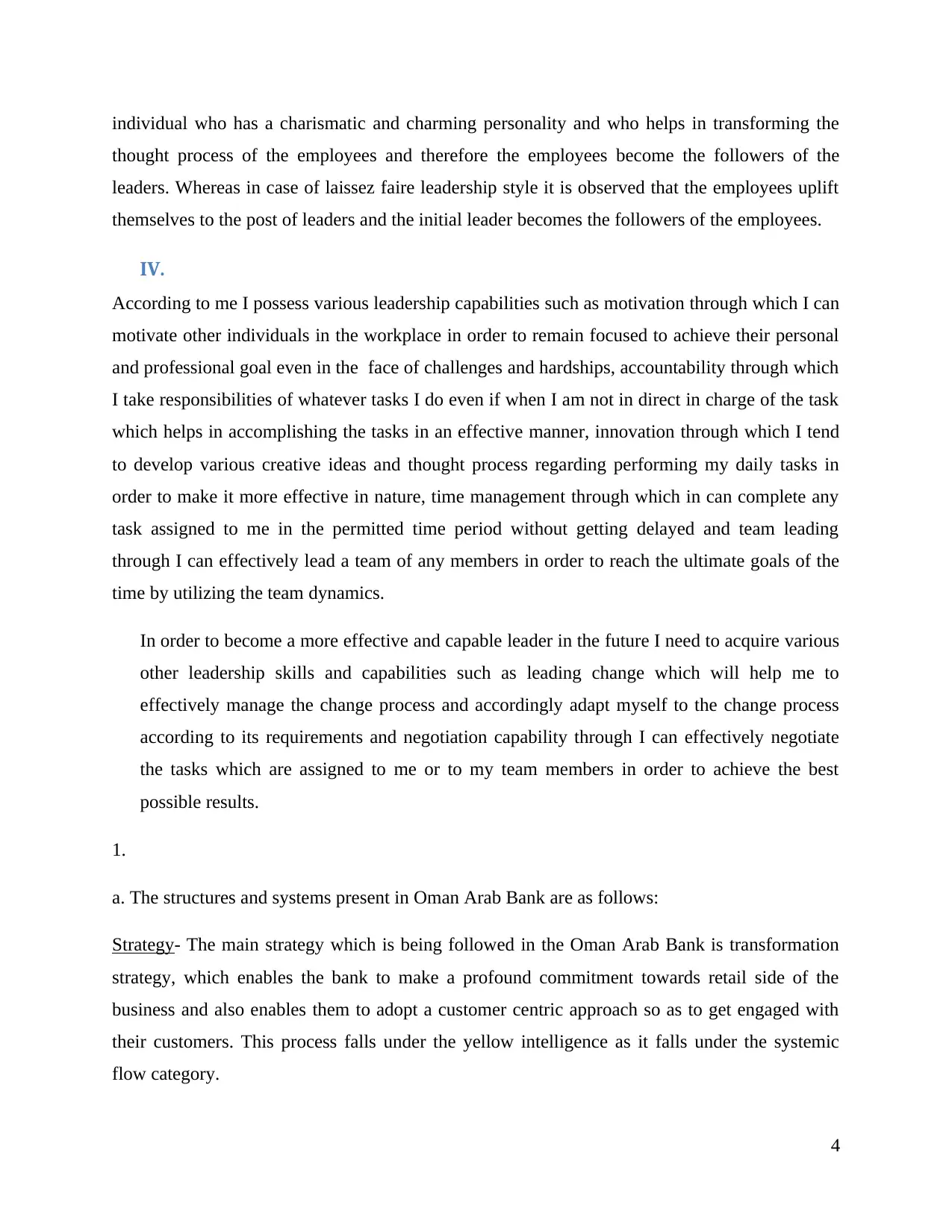
individual who has a charismatic and charming personality and who helps in transforming the
thought process of the employees and therefore the employees become the followers of the
leaders. Whereas in case of laissez faire leadership style it is observed that the employees uplift
themselves to the post of leaders and the initial leader becomes the followers of the employees.
IV.
According to me I possess various leadership capabilities such as motivation through which I can
motivate other individuals in the workplace in order to remain focused to achieve their personal
and professional goal even in the face of challenges and hardships, accountability through which
I take responsibilities of whatever tasks I do even if when I am not in direct in charge of the task
which helps in accomplishing the tasks in an effective manner, innovation through which I tend
to develop various creative ideas and thought process regarding performing my daily tasks in
order to make it more effective in nature, time management through which in can complete any
task assigned to me in the permitted time period without getting delayed and team leading
through I can effectively lead a team of any members in order to reach the ultimate goals of the
time by utilizing the team dynamics.
In order to become a more effective and capable leader in the future I need to acquire various
other leadership skills and capabilities such as leading change which will help me to
effectively manage the change process and accordingly adapt myself to the change process
according to its requirements and negotiation capability through I can effectively negotiate
the tasks which are assigned to me or to my team members in order to achieve the best
possible results.
1.
a. The structures and systems present in Oman Arab Bank are as follows:
Strategy- The main strategy which is being followed in the Oman Arab Bank is transformation
strategy, which enables the bank to make a profound commitment towards retail side of the
business and also enables them to adopt a customer centric approach so as to get engaged with
their customers. This process falls under the yellow intelligence as it falls under the systemic
flow category.
4
thought process of the employees and therefore the employees become the followers of the
leaders. Whereas in case of laissez faire leadership style it is observed that the employees uplift
themselves to the post of leaders and the initial leader becomes the followers of the employees.
IV.
According to me I possess various leadership capabilities such as motivation through which I can
motivate other individuals in the workplace in order to remain focused to achieve their personal
and professional goal even in the face of challenges and hardships, accountability through which
I take responsibilities of whatever tasks I do even if when I am not in direct in charge of the task
which helps in accomplishing the tasks in an effective manner, innovation through which I tend
to develop various creative ideas and thought process regarding performing my daily tasks in
order to make it more effective in nature, time management through which in can complete any
task assigned to me in the permitted time period without getting delayed and team leading
through I can effectively lead a team of any members in order to reach the ultimate goals of the
time by utilizing the team dynamics.
In order to become a more effective and capable leader in the future I need to acquire various
other leadership skills and capabilities such as leading change which will help me to
effectively manage the change process and accordingly adapt myself to the change process
according to its requirements and negotiation capability through I can effectively negotiate
the tasks which are assigned to me or to my team members in order to achieve the best
possible results.
1.
a. The structures and systems present in Oman Arab Bank are as follows:
Strategy- The main strategy which is being followed in the Oman Arab Bank is transformation
strategy, which enables the bank to make a profound commitment towards retail side of the
business and also enables them to adopt a customer centric approach so as to get engaged with
their customers. This process falls under the yellow intelligence as it falls under the systemic
flow category.
4
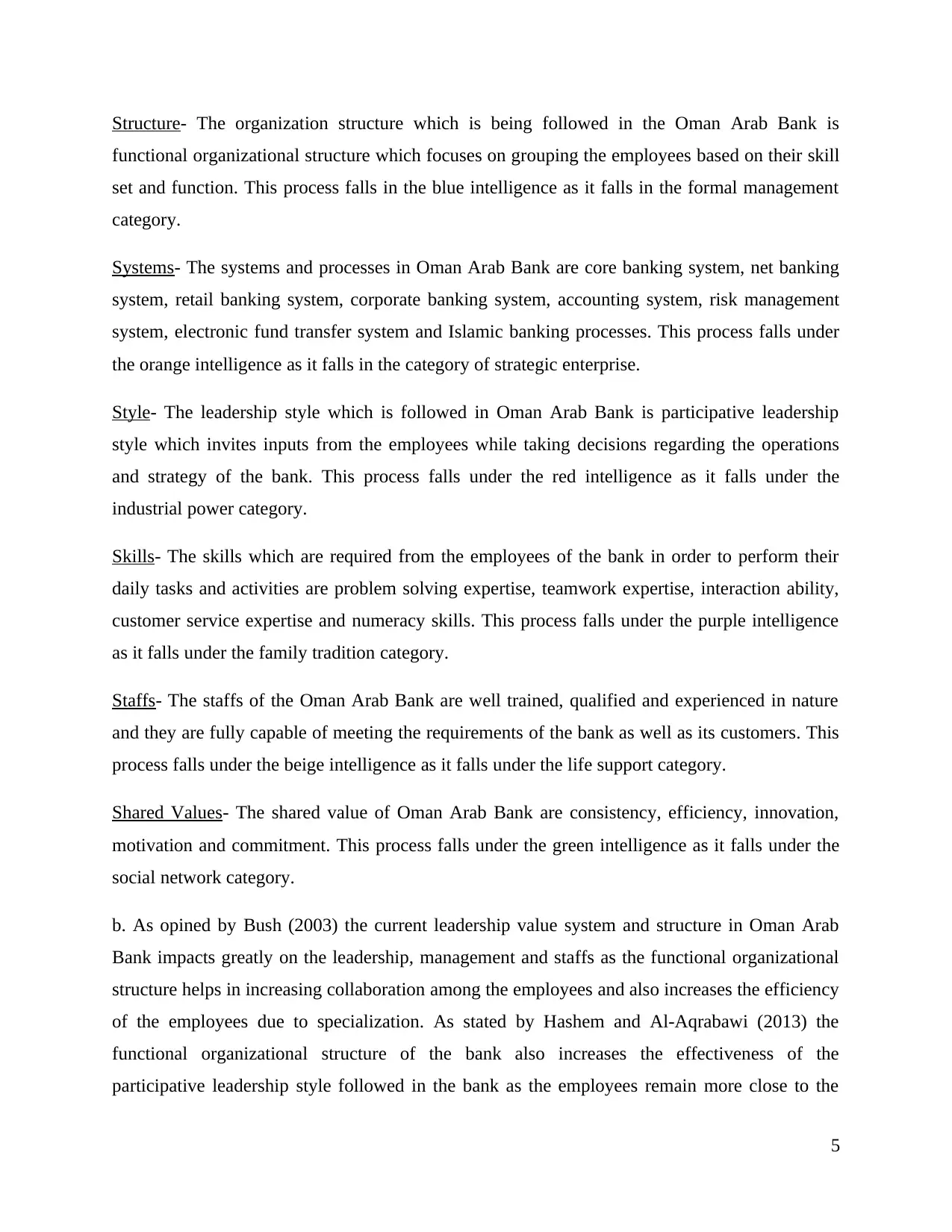
Structure- The organization structure which is being followed in the Oman Arab Bank is
functional organizational structure which focuses on grouping the employees based on their skill
set and function. This process falls in the blue intelligence as it falls in the formal management
category.
Systems- The systems and processes in Oman Arab Bank are core banking system, net banking
system, retail banking system, corporate banking system, accounting system, risk management
system, electronic fund transfer system and Islamic banking processes. This process falls under
the orange intelligence as it falls in the category of strategic enterprise.
Style- The leadership style which is followed in Oman Arab Bank is participative leadership
style which invites inputs from the employees while taking decisions regarding the operations
and strategy of the bank. This process falls under the red intelligence as it falls under the
industrial power category.
Skills- The skills which are required from the employees of the bank in order to perform their
daily tasks and activities are problem solving expertise, teamwork expertise, interaction ability,
customer service expertise and numeracy skills. This process falls under the purple intelligence
as it falls under the family tradition category.
Staffs- The staffs of the Oman Arab Bank are well trained, qualified and experienced in nature
and they are fully capable of meeting the requirements of the bank as well as its customers. This
process falls under the beige intelligence as it falls under the life support category.
Shared Values- The shared value of Oman Arab Bank are consistency, efficiency, innovation,
motivation and commitment. This process falls under the green intelligence as it falls under the
social network category.
b. As opined by Bush (2003) the current leadership value system and structure in Oman Arab
Bank impacts greatly on the leadership, management and staffs as the functional organizational
structure helps in increasing collaboration among the employees and also increases the efficiency
of the employees due to specialization. As stated by Hashem and Al-Aqrabawi (2013) the
functional organizational structure of the bank also increases the effectiveness of the
participative leadership style followed in the bank as the employees remain more close to the
5
functional organizational structure which focuses on grouping the employees based on their skill
set and function. This process falls in the blue intelligence as it falls in the formal management
category.
Systems- The systems and processes in Oman Arab Bank are core banking system, net banking
system, retail banking system, corporate banking system, accounting system, risk management
system, electronic fund transfer system and Islamic banking processes. This process falls under
the orange intelligence as it falls in the category of strategic enterprise.
Style- The leadership style which is followed in Oman Arab Bank is participative leadership
style which invites inputs from the employees while taking decisions regarding the operations
and strategy of the bank. This process falls under the red intelligence as it falls under the
industrial power category.
Skills- The skills which are required from the employees of the bank in order to perform their
daily tasks and activities are problem solving expertise, teamwork expertise, interaction ability,
customer service expertise and numeracy skills. This process falls under the purple intelligence
as it falls under the family tradition category.
Staffs- The staffs of the Oman Arab Bank are well trained, qualified and experienced in nature
and they are fully capable of meeting the requirements of the bank as well as its customers. This
process falls under the beige intelligence as it falls under the life support category.
Shared Values- The shared value of Oman Arab Bank are consistency, efficiency, innovation,
motivation and commitment. This process falls under the green intelligence as it falls under the
social network category.
b. As opined by Bush (2003) the current leadership value system and structure in Oman Arab
Bank impacts greatly on the leadership, management and staffs as the functional organizational
structure helps in increasing collaboration among the employees and also increases the efficiency
of the employees due to specialization. As stated by Hashem and Al-Aqrabawi (2013) the
functional organizational structure of the bank also increases the effectiveness of the
participative leadership style followed in the bank as the employees remain more close to the
5
⊘ This is a preview!⊘
Do you want full access?
Subscribe today to unlock all pages.

Trusted by 1+ million students worldwide
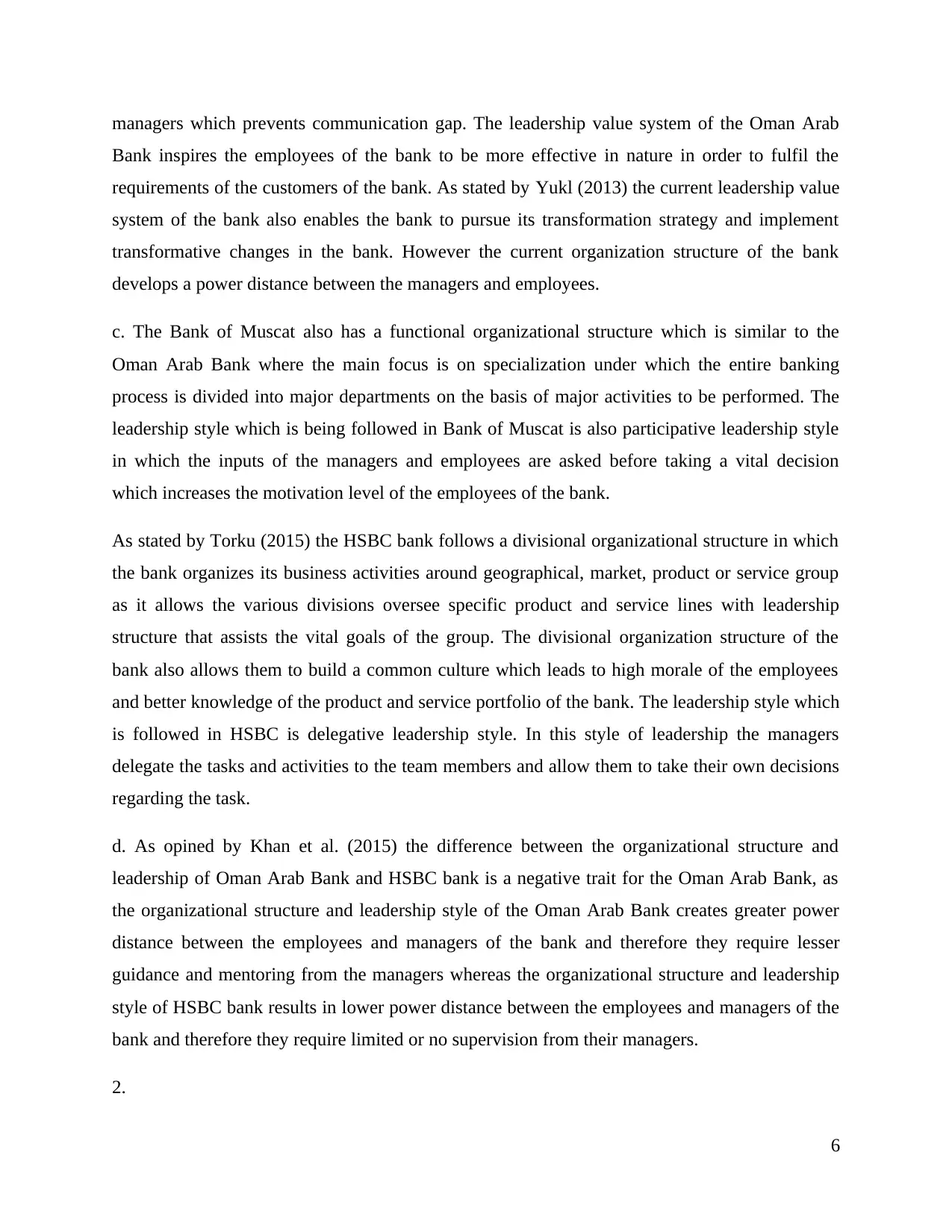
managers which prevents communication gap. The leadership value system of the Oman Arab
Bank inspires the employees of the bank to be more effective in nature in order to fulfil the
requirements of the customers of the bank. As stated by Yukl (2013) the current leadership value
system of the bank also enables the bank to pursue its transformation strategy and implement
transformative changes in the bank. However the current organization structure of the bank
develops a power distance between the managers and employees.
c. The Bank of Muscat also has a functional organizational structure which is similar to the
Oman Arab Bank where the main focus is on specialization under which the entire banking
process is divided into major departments on the basis of major activities to be performed. The
leadership style which is being followed in Bank of Muscat is also participative leadership style
in which the inputs of the managers and employees are asked before taking a vital decision
which increases the motivation level of the employees of the bank.
As stated by Torku (2015) the HSBC bank follows a divisional organizational structure in which
the bank organizes its business activities around geographical, market, product or service group
as it allows the various divisions oversee specific product and service lines with leadership
structure that assists the vital goals of the group. The divisional organization structure of the
bank also allows them to build a common culture which leads to high morale of the employees
and better knowledge of the product and service portfolio of the bank. The leadership style which
is followed in HSBC is delegative leadership style. In this style of leadership the managers
delegate the tasks and activities to the team members and allow them to take their own decisions
regarding the task.
d. As opined by Khan et al. (2015) the difference between the organizational structure and
leadership of Oman Arab Bank and HSBC bank is a negative trait for the Oman Arab Bank, as
the organizational structure and leadership style of the Oman Arab Bank creates greater power
distance between the employees and managers of the bank and therefore they require lesser
guidance and mentoring from the managers whereas the organizational structure and leadership
style of HSBC bank results in lower power distance between the employees and managers of the
bank and therefore they require limited or no supervision from their managers.
2.
6
Bank inspires the employees of the bank to be more effective in nature in order to fulfil the
requirements of the customers of the bank. As stated by Yukl (2013) the current leadership value
system of the bank also enables the bank to pursue its transformation strategy and implement
transformative changes in the bank. However the current organization structure of the bank
develops a power distance between the managers and employees.
c. The Bank of Muscat also has a functional organizational structure which is similar to the
Oman Arab Bank where the main focus is on specialization under which the entire banking
process is divided into major departments on the basis of major activities to be performed. The
leadership style which is being followed in Bank of Muscat is also participative leadership style
in which the inputs of the managers and employees are asked before taking a vital decision
which increases the motivation level of the employees of the bank.
As stated by Torku (2015) the HSBC bank follows a divisional organizational structure in which
the bank organizes its business activities around geographical, market, product or service group
as it allows the various divisions oversee specific product and service lines with leadership
structure that assists the vital goals of the group. The divisional organization structure of the
bank also allows them to build a common culture which leads to high morale of the employees
and better knowledge of the product and service portfolio of the bank. The leadership style which
is followed in HSBC is delegative leadership style. In this style of leadership the managers
delegate the tasks and activities to the team members and allow them to take their own decisions
regarding the task.
d. As opined by Khan et al. (2015) the difference between the organizational structure and
leadership of Oman Arab Bank and HSBC bank is a negative trait for the Oman Arab Bank, as
the organizational structure and leadership style of the Oman Arab Bank creates greater power
distance between the employees and managers of the bank and therefore they require lesser
guidance and mentoring from the managers whereas the organizational structure and leadership
style of HSBC bank results in lower power distance between the employees and managers of the
bank and therefore they require limited or no supervision from their managers.
2.
6
Paraphrase This Document
Need a fresh take? Get an instant paraphrase of this document with our AI Paraphraser
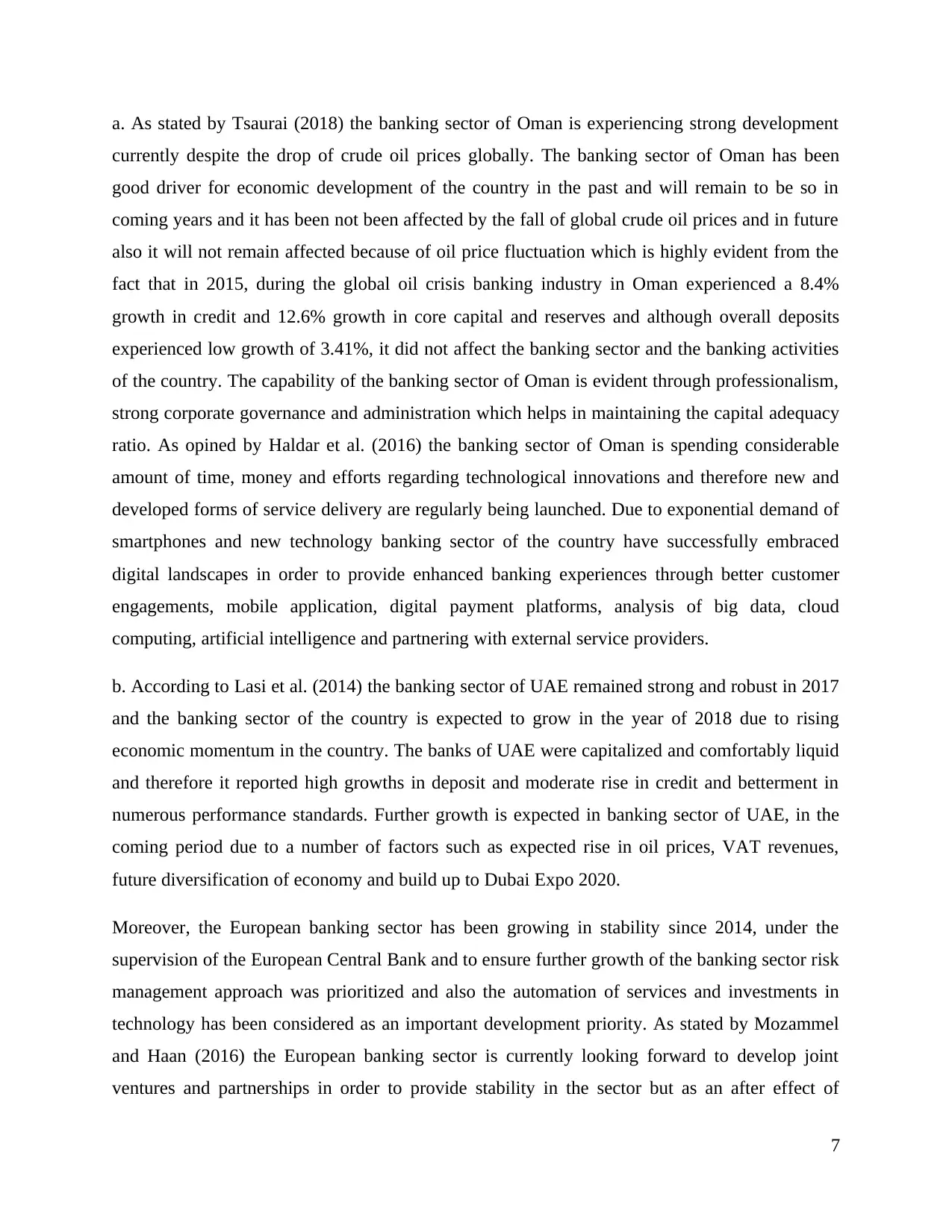
a. As stated by Tsaurai (2018) the banking sector of Oman is experiencing strong development
currently despite the drop of crude oil prices globally. The banking sector of Oman has been
good driver for economic development of the country in the past and will remain to be so in
coming years and it has been not been affected by the fall of global crude oil prices and in future
also it will not remain affected because of oil price fluctuation which is highly evident from the
fact that in 2015, during the global oil crisis banking industry in Oman experienced a 8.4%
growth in credit and 12.6% growth in core capital and reserves and although overall deposits
experienced low growth of 3.41%, it did not affect the banking sector and the banking activities
of the country. The capability of the banking sector of Oman is evident through professionalism,
strong corporate governance and administration which helps in maintaining the capital adequacy
ratio. As opined by Haldar et al. (2016) the banking sector of Oman is spending considerable
amount of time, money and efforts regarding technological innovations and therefore new and
developed forms of service delivery are regularly being launched. Due to exponential demand of
smartphones and new technology banking sector of the country have successfully embraced
digital landscapes in order to provide enhanced banking experiences through better customer
engagements, mobile application, digital payment platforms, analysis of big data, cloud
computing, artificial intelligence and partnering with external service providers.
b. According to Lasi et al. (2014) the banking sector of UAE remained strong and robust in 2017
and the banking sector of the country is expected to grow in the year of 2018 due to rising
economic momentum in the country. The banks of UAE were capitalized and comfortably liquid
and therefore it reported high growths in deposit and moderate rise in credit and betterment in
numerous performance standards. Further growth is expected in banking sector of UAE, in the
coming period due to a number of factors such as expected rise in oil prices, VAT revenues,
future diversification of economy and build up to Dubai Expo 2020.
Moreover, the European banking sector has been growing in stability since 2014, under the
supervision of the European Central Bank and to ensure further growth of the banking sector risk
management approach was prioritized and also the automation of services and investments in
technology has been considered as an important development priority. As stated by Mozammel
and Haan (2016) the European banking sector is currently looking forward to develop joint
ventures and partnerships in order to provide stability in the sector but as an after effect of
7
currently despite the drop of crude oil prices globally. The banking sector of Oman has been
good driver for economic development of the country in the past and will remain to be so in
coming years and it has been not been affected by the fall of global crude oil prices and in future
also it will not remain affected because of oil price fluctuation which is highly evident from the
fact that in 2015, during the global oil crisis banking industry in Oman experienced a 8.4%
growth in credit and 12.6% growth in core capital and reserves and although overall deposits
experienced low growth of 3.41%, it did not affect the banking sector and the banking activities
of the country. The capability of the banking sector of Oman is evident through professionalism,
strong corporate governance and administration which helps in maintaining the capital adequacy
ratio. As opined by Haldar et al. (2016) the banking sector of Oman is spending considerable
amount of time, money and efforts regarding technological innovations and therefore new and
developed forms of service delivery are regularly being launched. Due to exponential demand of
smartphones and new technology banking sector of the country have successfully embraced
digital landscapes in order to provide enhanced banking experiences through better customer
engagements, mobile application, digital payment platforms, analysis of big data, cloud
computing, artificial intelligence and partnering with external service providers.
b. According to Lasi et al. (2014) the banking sector of UAE remained strong and robust in 2017
and the banking sector of the country is expected to grow in the year of 2018 due to rising
economic momentum in the country. The banks of UAE were capitalized and comfortably liquid
and therefore it reported high growths in deposit and moderate rise in credit and betterment in
numerous performance standards. Further growth is expected in banking sector of UAE, in the
coming period due to a number of factors such as expected rise in oil prices, VAT revenues,
future diversification of economy and build up to Dubai Expo 2020.
Moreover, the European banking sector has been growing in stability since 2014, under the
supervision of the European Central Bank and to ensure further growth of the banking sector risk
management approach was prioritized and also the automation of services and investments in
technology has been considered as an important development priority. As stated by Mozammel
and Haan (2016) the European banking sector is currently looking forward to develop joint
ventures and partnerships in order to provide stability in the sector but as an after effect of
7
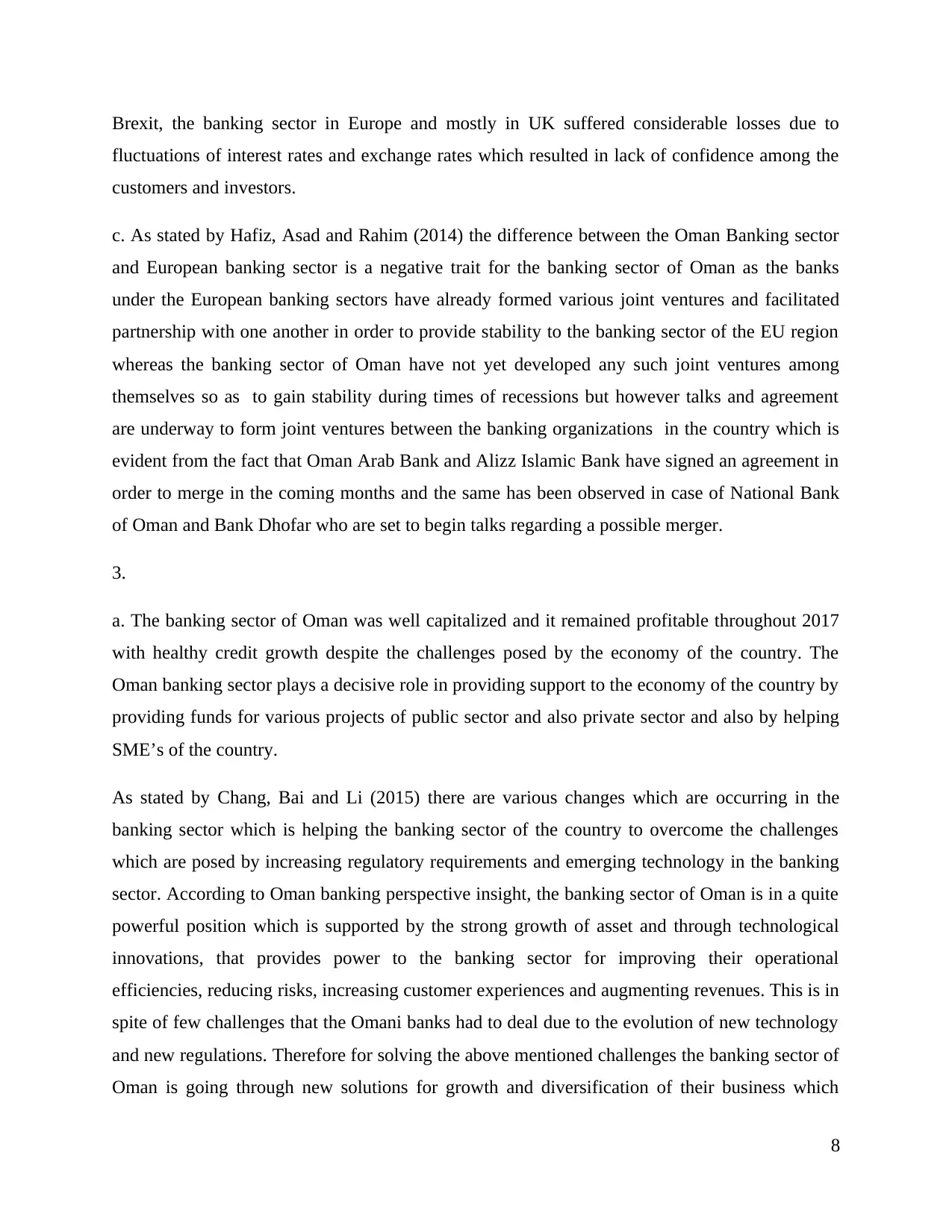
Brexit, the banking sector in Europe and mostly in UK suffered considerable losses due to
fluctuations of interest rates and exchange rates which resulted in lack of confidence among the
customers and investors.
c. As stated by Hafiz, Asad and Rahim (2014) the difference between the Oman Banking sector
and European banking sector is a negative trait for the banking sector of Oman as the banks
under the European banking sectors have already formed various joint ventures and facilitated
partnership with one another in order to provide stability to the banking sector of the EU region
whereas the banking sector of Oman have not yet developed any such joint ventures among
themselves so as to gain stability during times of recessions but however talks and agreement
are underway to form joint ventures between the banking organizations in the country which is
evident from the fact that Oman Arab Bank and Alizz Islamic Bank have signed an agreement in
order to merge in the coming months and the same has been observed in case of National Bank
of Oman and Bank Dhofar who are set to begin talks regarding a possible merger.
3.
a. The banking sector of Oman was well capitalized and it remained profitable throughout 2017
with healthy credit growth despite the challenges posed by the economy of the country. The
Oman banking sector plays a decisive role in providing support to the economy of the country by
providing funds for various projects of public sector and also private sector and also by helping
SME’s of the country.
As stated by Chang, Bai and Li (2015) there are various changes which are occurring in the
banking sector which is helping the banking sector of the country to overcome the challenges
which are posed by increasing regulatory requirements and emerging technology in the banking
sector. According to Oman banking perspective insight, the banking sector of Oman is in a quite
powerful position which is supported by the strong growth of asset and through technological
innovations, that provides power to the banking sector for improving their operational
efficiencies, reducing risks, increasing customer experiences and augmenting revenues. This is in
spite of few challenges that the Omani banks had to deal due to the evolution of new technology
and new regulations. Therefore for solving the above mentioned challenges the banking sector of
Oman is going through new solutions for growth and diversification of their business which
8
fluctuations of interest rates and exchange rates which resulted in lack of confidence among the
customers and investors.
c. As stated by Hafiz, Asad and Rahim (2014) the difference between the Oman Banking sector
and European banking sector is a negative trait for the banking sector of Oman as the banks
under the European banking sectors have already formed various joint ventures and facilitated
partnership with one another in order to provide stability to the banking sector of the EU region
whereas the banking sector of Oman have not yet developed any such joint ventures among
themselves so as to gain stability during times of recessions but however talks and agreement
are underway to form joint ventures between the banking organizations in the country which is
evident from the fact that Oman Arab Bank and Alizz Islamic Bank have signed an agreement in
order to merge in the coming months and the same has been observed in case of National Bank
of Oman and Bank Dhofar who are set to begin talks regarding a possible merger.
3.
a. The banking sector of Oman was well capitalized and it remained profitable throughout 2017
with healthy credit growth despite the challenges posed by the economy of the country. The
Oman banking sector plays a decisive role in providing support to the economy of the country by
providing funds for various projects of public sector and also private sector and also by helping
SME’s of the country.
As stated by Chang, Bai and Li (2015) there are various changes which are occurring in the
banking sector which is helping the banking sector of the country to overcome the challenges
which are posed by increasing regulatory requirements and emerging technology in the banking
sector. According to Oman banking perspective insight, the banking sector of Oman is in a quite
powerful position which is supported by the strong growth of asset and through technological
innovations, that provides power to the banking sector for improving their operational
efficiencies, reducing risks, increasing customer experiences and augmenting revenues. This is in
spite of few challenges that the Omani banks had to deal due to the evolution of new technology
and new regulations. Therefore for solving the above mentioned challenges the banking sector of
Oman is going through new solutions for growth and diversification of their business which
8
⊘ This is a preview!⊘
Do you want full access?
Subscribe today to unlock all pages.

Trusted by 1+ million students worldwide
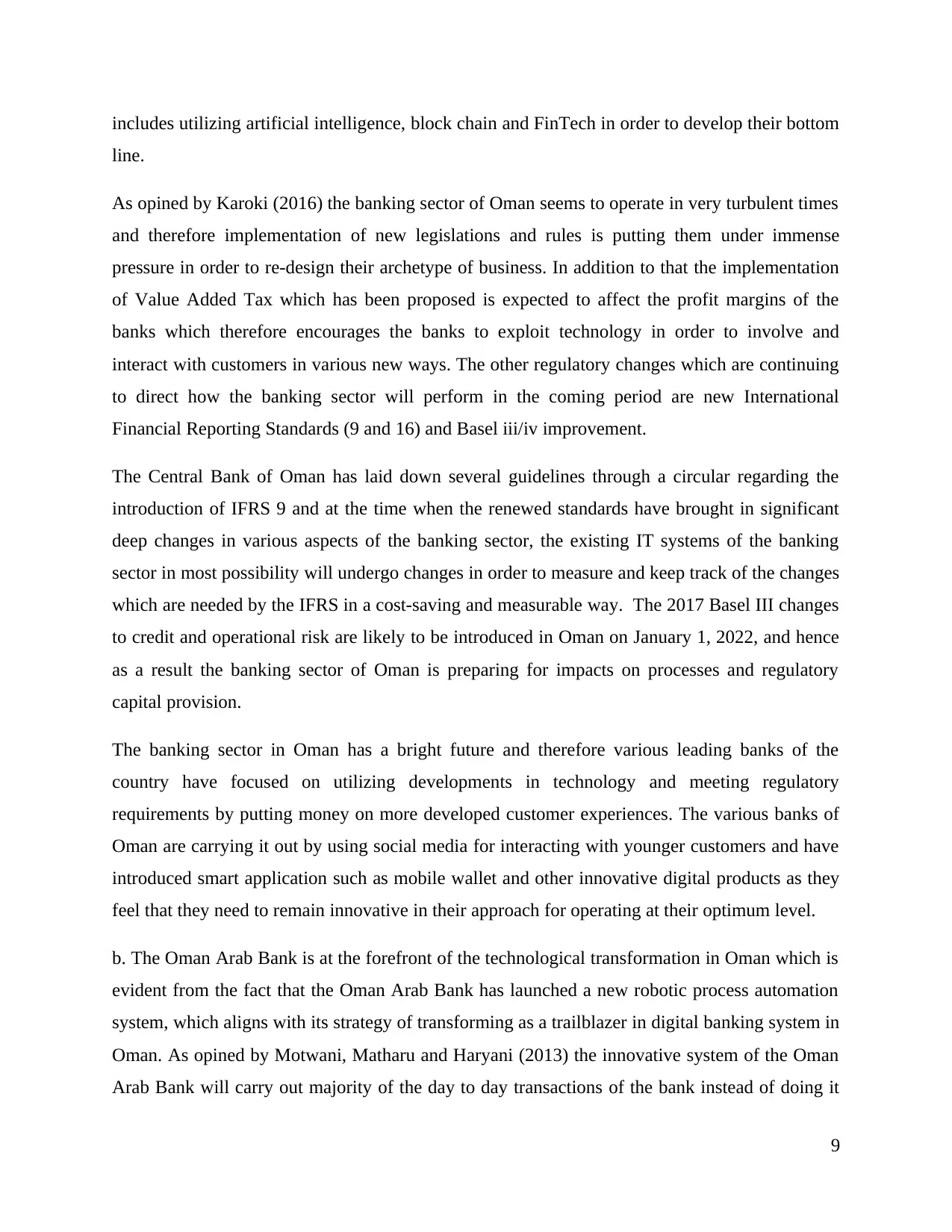
includes utilizing artificial intelligence, block chain and FinTech in order to develop their bottom
line.
As opined by Karoki (2016) the banking sector of Oman seems to operate in very turbulent times
and therefore implementation of new legislations and rules is putting them under immense
pressure in order to re-design their archetype of business. In addition to that the implementation
of Value Added Tax which has been proposed is expected to affect the profit margins of the
banks which therefore encourages the banks to exploit technology in order to involve and
interact with customers in various new ways. The other regulatory changes which are continuing
to direct how the banking sector will perform in the coming period are new International
Financial Reporting Standards (9 and 16) and Basel iii/iv improvement.
The Central Bank of Oman has laid down several guidelines through a circular regarding the
introduction of IFRS 9 and at the time when the renewed standards have brought in significant
deep changes in various aspects of the banking sector, the existing IT systems of the banking
sector in most possibility will undergo changes in order to measure and keep track of the changes
which are needed by the IFRS in a cost-saving and measurable way. The 2017 Basel III changes
to credit and operational risk are likely to be introduced in Oman on January 1, 2022, and hence
as a result the banking sector of Oman is preparing for impacts on processes and regulatory
capital provision.
The banking sector in Oman has a bright future and therefore various leading banks of the
country have focused on utilizing developments in technology and meeting regulatory
requirements by putting money on more developed customer experiences. The various banks of
Oman are carrying it out by using social media for interacting with younger customers and have
introduced smart application such as mobile wallet and other innovative digital products as they
feel that they need to remain innovative in their approach for operating at their optimum level.
b. The Oman Arab Bank is at the forefront of the technological transformation in Oman which is
evident from the fact that the Oman Arab Bank has launched a new robotic process automation
system, which aligns with its strategy of transforming as a trailblazer in digital banking system in
Oman. As opined by Motwani, Matharu and Haryani (2013) the innovative system of the Oman
Arab Bank will carry out majority of the day to day transactions of the bank instead of doing it
9
line.
As opined by Karoki (2016) the banking sector of Oman seems to operate in very turbulent times
and therefore implementation of new legislations and rules is putting them under immense
pressure in order to re-design their archetype of business. In addition to that the implementation
of Value Added Tax which has been proposed is expected to affect the profit margins of the
banks which therefore encourages the banks to exploit technology in order to involve and
interact with customers in various new ways. The other regulatory changes which are continuing
to direct how the banking sector will perform in the coming period are new International
Financial Reporting Standards (9 and 16) and Basel iii/iv improvement.
The Central Bank of Oman has laid down several guidelines through a circular regarding the
introduction of IFRS 9 and at the time when the renewed standards have brought in significant
deep changes in various aspects of the banking sector, the existing IT systems of the banking
sector in most possibility will undergo changes in order to measure and keep track of the changes
which are needed by the IFRS in a cost-saving and measurable way. The 2017 Basel III changes
to credit and operational risk are likely to be introduced in Oman on January 1, 2022, and hence
as a result the banking sector of Oman is preparing for impacts on processes and regulatory
capital provision.
The banking sector in Oman has a bright future and therefore various leading banks of the
country have focused on utilizing developments in technology and meeting regulatory
requirements by putting money on more developed customer experiences. The various banks of
Oman are carrying it out by using social media for interacting with younger customers and have
introduced smart application such as mobile wallet and other innovative digital products as they
feel that they need to remain innovative in their approach for operating at their optimum level.
b. The Oman Arab Bank is at the forefront of the technological transformation in Oman which is
evident from the fact that the Oman Arab Bank has launched a new robotic process automation
system, which aligns with its strategy of transforming as a trailblazer in digital banking system in
Oman. As opined by Motwani, Matharu and Haryani (2013) the innovative system of the Oman
Arab Bank will carry out majority of the day to day transactions of the bank instead of doing it
9
Paraphrase This Document
Need a fresh take? Get an instant paraphrase of this document with our AI Paraphraser
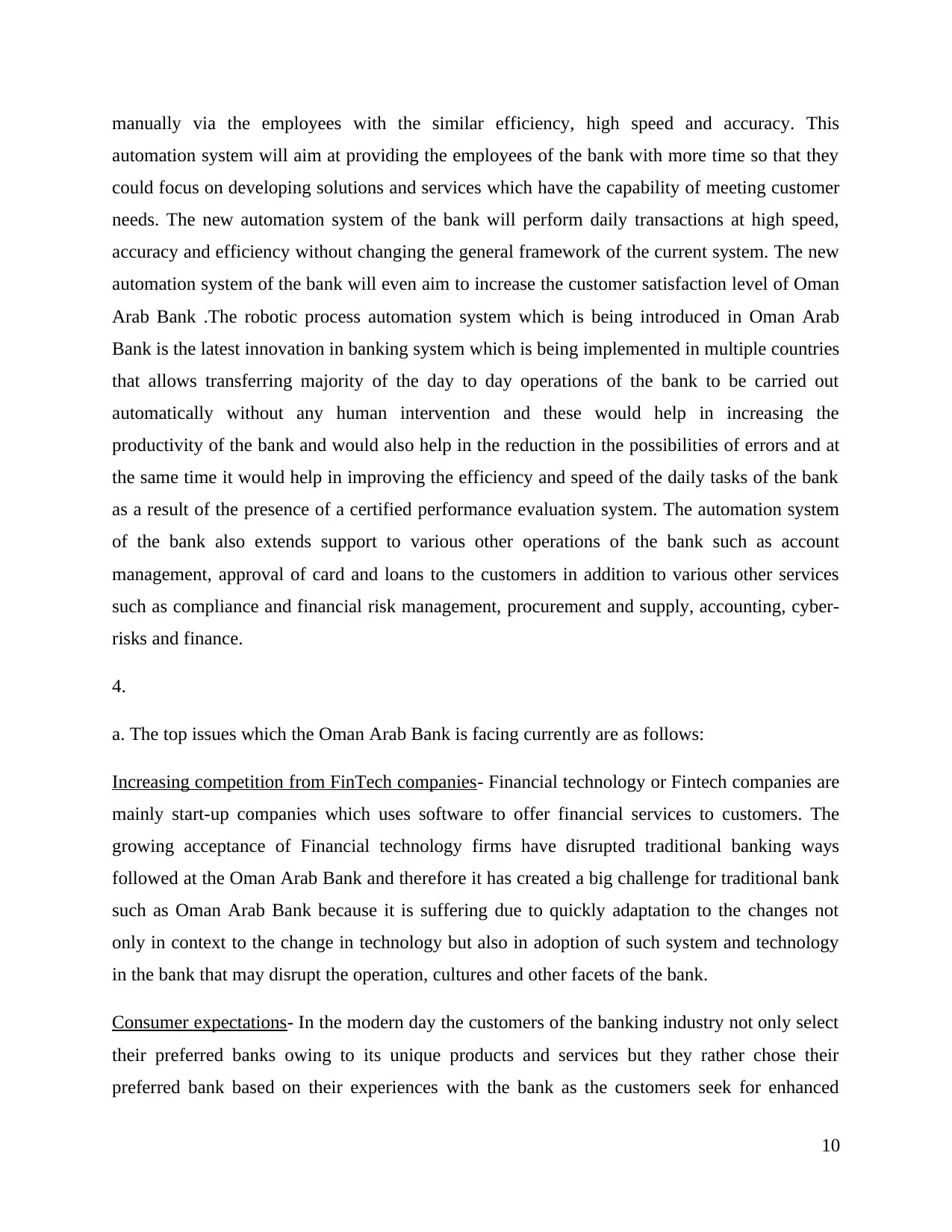
manually via the employees with the similar efficiency, high speed and accuracy. This
automation system will aim at providing the employees of the bank with more time so that they
could focus on developing solutions and services which have the capability of meeting customer
needs. The new automation system of the bank will perform daily transactions at high speed,
accuracy and efficiency without changing the general framework of the current system. The new
automation system of the bank will even aim to increase the customer satisfaction level of Oman
Arab Bank .The robotic process automation system which is being introduced in Oman Arab
Bank is the latest innovation in banking system which is being implemented in multiple countries
that allows transferring majority of the day to day operations of the bank to be carried out
automatically without any human intervention and these would help in increasing the
productivity of the bank and would also help in the reduction in the possibilities of errors and at
the same time it would help in improving the efficiency and speed of the daily tasks of the bank
as a result of the presence of a certified performance evaluation system. The automation system
of the bank also extends support to various other operations of the bank such as account
management, approval of card and loans to the customers in addition to various other services
such as compliance and financial risk management, procurement and supply, accounting, cyber-
risks and finance.
4.
a. The top issues which the Oman Arab Bank is facing currently are as follows:
Increasing competition from FinTech companies- Financial technology or Fintech companies are
mainly start-up companies which uses software to offer financial services to customers. The
growing acceptance of Financial technology firms have disrupted traditional banking ways
followed at the Oman Arab Bank and therefore it has created a big challenge for traditional bank
such as Oman Arab Bank because it is suffering due to quickly adaptation to the changes not
only in context to the change in technology but also in adoption of such system and technology
in the bank that may disrupt the operation, cultures and other facets of the bank.
Consumer expectations- In the modern day the customers of the banking industry not only select
their preferred banks owing to its unique products and services but they rather chose their
preferred bank based on their experiences with the bank as the customers seek for enhanced
10
automation system will aim at providing the employees of the bank with more time so that they
could focus on developing solutions and services which have the capability of meeting customer
needs. The new automation system of the bank will perform daily transactions at high speed,
accuracy and efficiency without changing the general framework of the current system. The new
automation system of the bank will even aim to increase the customer satisfaction level of Oman
Arab Bank .The robotic process automation system which is being introduced in Oman Arab
Bank is the latest innovation in banking system which is being implemented in multiple countries
that allows transferring majority of the day to day operations of the bank to be carried out
automatically without any human intervention and these would help in increasing the
productivity of the bank and would also help in the reduction in the possibilities of errors and at
the same time it would help in improving the efficiency and speed of the daily tasks of the bank
as a result of the presence of a certified performance evaluation system. The automation system
of the bank also extends support to various other operations of the bank such as account
management, approval of card and loans to the customers in addition to various other services
such as compliance and financial risk management, procurement and supply, accounting, cyber-
risks and finance.
4.
a. The top issues which the Oman Arab Bank is facing currently are as follows:
Increasing competition from FinTech companies- Financial technology or Fintech companies are
mainly start-up companies which uses software to offer financial services to customers. The
growing acceptance of Financial technology firms have disrupted traditional banking ways
followed at the Oman Arab Bank and therefore it has created a big challenge for traditional bank
such as Oman Arab Bank because it is suffering due to quickly adaptation to the changes not
only in context to the change in technology but also in adoption of such system and technology
in the bank that may disrupt the operation, cultures and other facets of the bank.
Consumer expectations- In the modern day the customers of the banking industry not only select
their preferred banks owing to its unique products and services but they rather chose their
preferred bank based on their experiences with the bank as the customers seek for enhanced
10
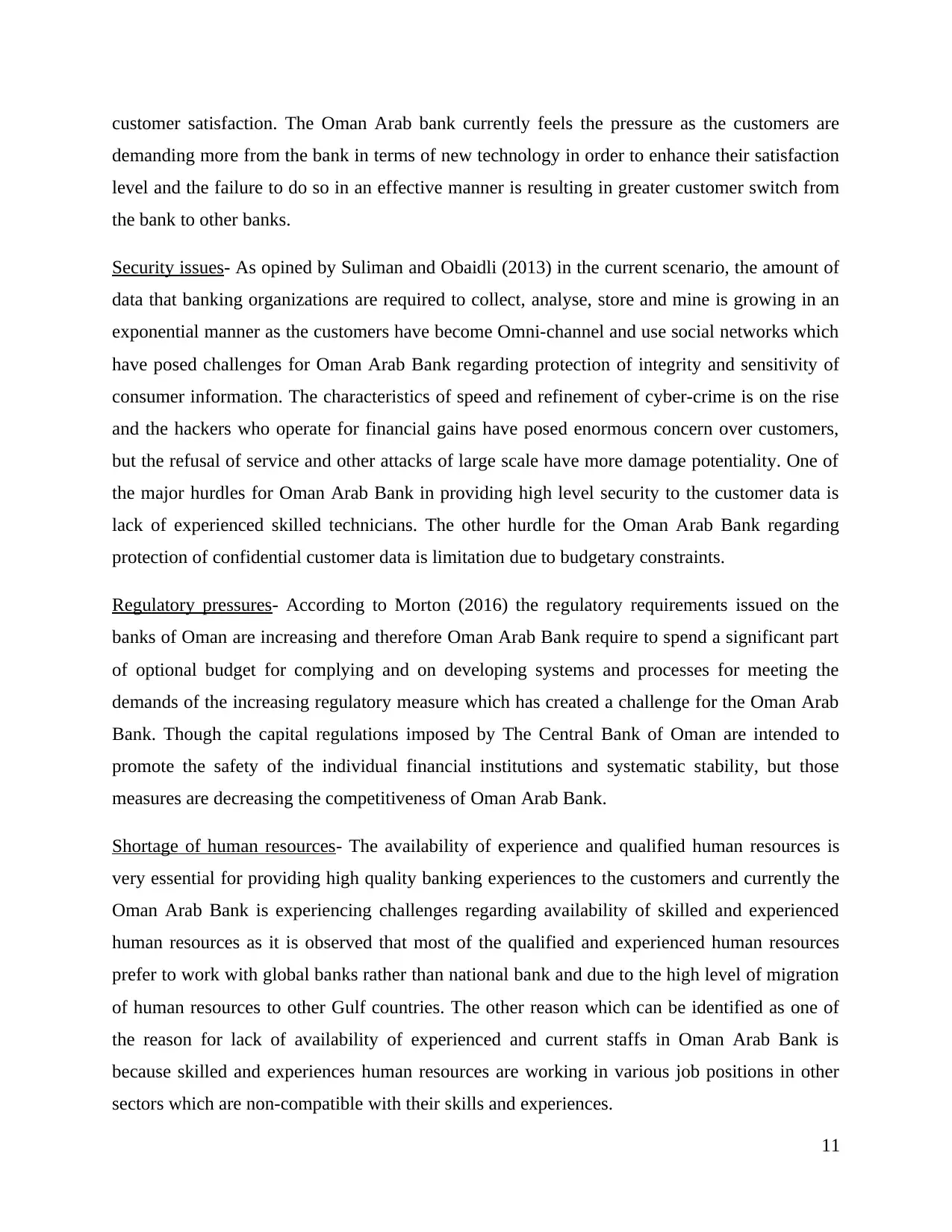
customer satisfaction. The Oman Arab bank currently feels the pressure as the customers are
demanding more from the bank in terms of new technology in order to enhance their satisfaction
level and the failure to do so in an effective manner is resulting in greater customer switch from
the bank to other banks.
Security issues- As opined by Suliman and Obaidli (2013) in the current scenario, the amount of
data that banking organizations are required to collect, analyse, store and mine is growing in an
exponential manner as the customers have become Omni-channel and use social networks which
have posed challenges for Oman Arab Bank regarding protection of integrity and sensitivity of
consumer information. The characteristics of speed and refinement of cyber-crime is on the rise
and the hackers who operate for financial gains have posed enormous concern over customers,
but the refusal of service and other attacks of large scale have more damage potentiality. One of
the major hurdles for Oman Arab Bank in providing high level security to the customer data is
lack of experienced skilled technicians. The other hurdle for the Oman Arab Bank regarding
protection of confidential customer data is limitation due to budgetary constraints.
Regulatory pressures- According to Morton (2016) the regulatory requirements issued on the
banks of Oman are increasing and therefore Oman Arab Bank require to spend a significant part
of optional budget for complying and on developing systems and processes for meeting the
demands of the increasing regulatory measure which has created a challenge for the Oman Arab
Bank. Though the capital regulations imposed by The Central Bank of Oman are intended to
promote the safety of the individual financial institutions and systematic stability, but those
measures are decreasing the competitiveness of Oman Arab Bank.
Shortage of human resources- The availability of experience and qualified human resources is
very essential for providing high quality banking experiences to the customers and currently the
Oman Arab Bank is experiencing challenges regarding availability of skilled and experienced
human resources as it is observed that most of the qualified and experienced human resources
prefer to work with global banks rather than national bank and due to the high level of migration
of human resources to other Gulf countries. The other reason which can be identified as one of
the reason for lack of availability of experienced and current staffs in Oman Arab Bank is
because skilled and experiences human resources are working in various job positions in other
sectors which are non-compatible with their skills and experiences.
11
demanding more from the bank in terms of new technology in order to enhance their satisfaction
level and the failure to do so in an effective manner is resulting in greater customer switch from
the bank to other banks.
Security issues- As opined by Suliman and Obaidli (2013) in the current scenario, the amount of
data that banking organizations are required to collect, analyse, store and mine is growing in an
exponential manner as the customers have become Omni-channel and use social networks which
have posed challenges for Oman Arab Bank regarding protection of integrity and sensitivity of
consumer information. The characteristics of speed and refinement of cyber-crime is on the rise
and the hackers who operate for financial gains have posed enormous concern over customers,
but the refusal of service and other attacks of large scale have more damage potentiality. One of
the major hurdles for Oman Arab Bank in providing high level security to the customer data is
lack of experienced skilled technicians. The other hurdle for the Oman Arab Bank regarding
protection of confidential customer data is limitation due to budgetary constraints.
Regulatory pressures- According to Morton (2016) the regulatory requirements issued on the
banks of Oman are increasing and therefore Oman Arab Bank require to spend a significant part
of optional budget for complying and on developing systems and processes for meeting the
demands of the increasing regulatory measure which has created a challenge for the Oman Arab
Bank. Though the capital regulations imposed by The Central Bank of Oman are intended to
promote the safety of the individual financial institutions and systematic stability, but those
measures are decreasing the competitiveness of Oman Arab Bank.
Shortage of human resources- The availability of experience and qualified human resources is
very essential for providing high quality banking experiences to the customers and currently the
Oman Arab Bank is experiencing challenges regarding availability of skilled and experienced
human resources as it is observed that most of the qualified and experienced human resources
prefer to work with global banks rather than national bank and due to the high level of migration
of human resources to other Gulf countries. The other reason which can be identified as one of
the reason for lack of availability of experienced and current staffs in Oman Arab Bank is
because skilled and experiences human resources are working in various job positions in other
sectors which are non-compatible with their skills and experiences.
11
⊘ This is a preview!⊘
Do you want full access?
Subscribe today to unlock all pages.

Trusted by 1+ million students worldwide
1 out of 20
Related Documents
Your All-in-One AI-Powered Toolkit for Academic Success.
+13062052269
info@desklib.com
Available 24*7 on WhatsApp / Email
![[object Object]](/_next/static/media/star-bottom.7253800d.svg)
Unlock your academic potential
Copyright © 2020–2025 A2Z Services. All Rights Reserved. Developed and managed by ZUCOL.




